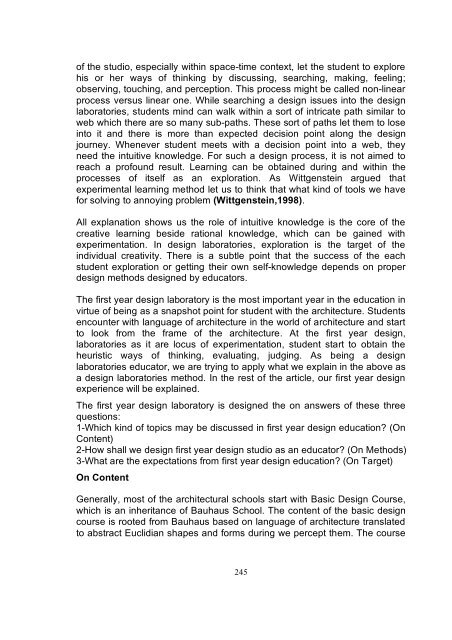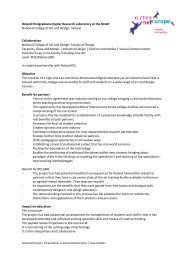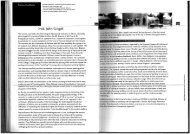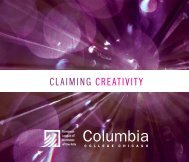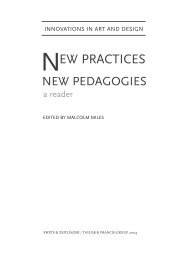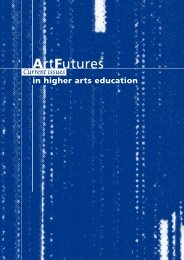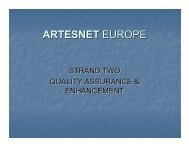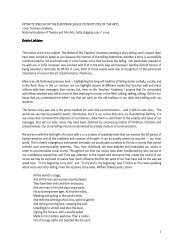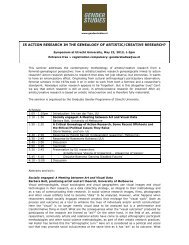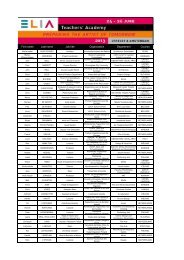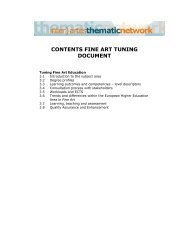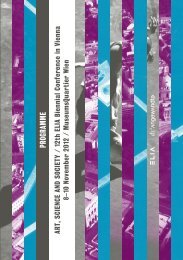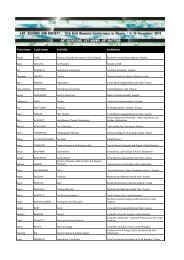part_1.pdf - Elia
part_1.pdf - Elia
part_1.pdf - Elia
Create successful ePaper yourself
Turn your PDF publications into a flip-book with our unique Google optimized e-Paper software.
of the studio, especially within space-time context, let the student to explore<br />
his or her ways of thinking by discussing, searching, making, feeling;<br />
observing, touching, and perception. This process might be called non-linear<br />
process versus linear one. While searching a design issues into the design<br />
laboratories, students mind can walk within a sort of intricate path similar to<br />
web which there are so many sub-paths. These sort of paths let them to lose<br />
into it and there is more than expected decision point along the design<br />
journey. Whenever student meets with a decision point into a web, they<br />
need the intuitive knowledge. For such a design process, it is not aimed to<br />
reach a profound result. Learning can be obtained during and within the<br />
processes of itself as an exploration. As Wittgenstein argued that<br />
experimental learning method let us to think that what kind of tools we have<br />
for solving to annoying problem (Wittgenstein,1998).<br />
All explanation shows us the role of intuitive knowledge is the core of the<br />
creative learning beside rational knowledge, which can be gained with<br />
experimentation. In design laboratories, exploration is the target of the<br />
individual creativity. There is a subtle point that the success of the each<br />
student exploration or getting their own self-knowledge depends on proper<br />
design methods designed by educators.<br />
The first year design laboratory is the most important year in the education in<br />
virtue of being as a snapshot point for student with the architecture. Students<br />
encounter with language of architecture in the world of architecture and start<br />
to look from the frame of the architecture. At the first year design,<br />
laboratories as it are locus of experimentation, student start to obtain the<br />
heuristic ways of thinking, evaluating, judging. As being a design<br />
laboratories educator, we are trying to apply what we explain in the above as<br />
a design laboratories method. In the rest of the article, our first year design<br />
experience will be explained.<br />
The first year design laboratory is designed the on answers of these three<br />
questions:<br />
1-Which kind of topics may be discussed in first year design education? (On<br />
Content)<br />
2-How shall we design first year design studio as an educator? (On Methods)<br />
3-What are the expectations from first year design education? (On Target)<br />
On Content<br />
Generally, most of the architectural schools start with Basic Design Course,<br />
which is an inheritance of Bauhaus School. The content of the basic design<br />
course is rooted from Bauhaus based on language of architecture translated<br />
to abstract Euclidian shapes and forms during we percept them. The course<br />
245


